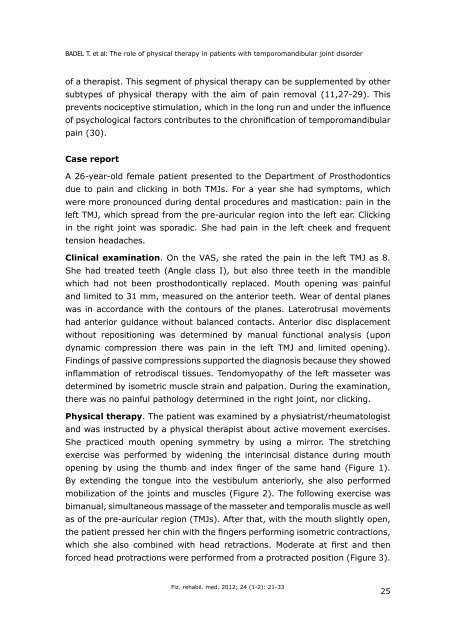2012-1-2 - Hrvatsko društvo za fizikalnu i rehabilitacijsku medicinu ...
2012-1-2 - Hrvatsko društvo za fizikalnu i rehabilitacijsku medicinu ...
2012-1-2 - Hrvatsko društvo za fizikalnu i rehabilitacijsku medicinu ...
Create successful ePaper yourself
Turn your PDF publications into a flip-book with our unique Google optimized e-Paper software.
BADEL T. et al: The role of physical therapy in patients with temporomandibular joint disorder<br />
of a therapist. This segment of physical therapy can be supplemented by other<br />
subtypes of physical therapy with the aim of pain removal (11,27-29). This<br />
prevents nociceptive stimulation, which in the long run and under the influence<br />
of psychological factors contributes to the chronification of temporomandibular<br />
pain (30).<br />
Case report<br />
A 26-year-old female patient presented to the Department of Prosthodontics<br />
due to pain and clicking in both TMJs. For a year she had symptoms, which<br />
were more pronounced during dental procedures and mastication: pain in the<br />
left TMJ, which spread from the pre-auricular region into the left ear. Clicking<br />
in the right joint was sporadic. She had pain in the left cheek and frequent<br />
tension headaches.<br />
Clinical examination. On the VAS, she rated the pain in the left TMJ as 8.<br />
She had treated teeth (Angle class I), but also three teeth in the mandible<br />
which had not been prosthodontically replaced. Mouth opening was painful<br />
and limited to 31 mm, measured on the anterior teeth. Wear of dental planes<br />
was in accordance with the contours of the planes. Laterotrusal movements<br />
had anterior guidance without balanced contacts. Anterior disc displacement<br />
without repositioning was determined by manual functional analysis (upon<br />
dynamic compression there was pain in the left TMJ and limited opening).<br />
Findings of passive compressions supported the diagnosis because they showed<br />
inflammation of retrodiscal tissues. Tendomyopathy of the left masseter was<br />
determined by isometric muscle strain and palpation. During the examination,<br />
there was no painful pathology determined in the right joint, nor clicking.<br />
Physical therapy. The patient was examined by a physiatrist/rheumatologist<br />
and was instructed by a physical therapist about active movement exercises.<br />
She practiced mouth opening symmetry by using a mirror. The stretching<br />
exercise was performed by widening the interincisal distance during mouth<br />
opening by using the thumb and index finger of the same hand (Figure 1).<br />
By extending the tongue into the vestibulum anteriorly, she also performed<br />
mobili<strong>za</strong>tion of the joints and muscles (Figure 2). The following exercise was<br />
bimanual, simultaneous massage of the masseter and temporalis muscle as well<br />
as of the pre-auricular region (TMJs). After that, with the mouth slightly open,<br />
the patient pressed her chin with the fingers performing isometric contractions,<br />
which she also combined with head retractions. Moderate at first and then<br />
forced head protractions were performed from a protracted position (Figure 3).<br />
Fiz. rehabil. med. <strong>2012</strong>; 24 (1-2): 21-33<br />
25


